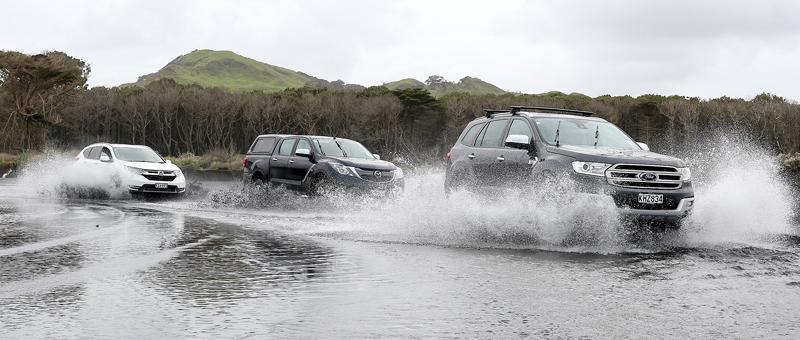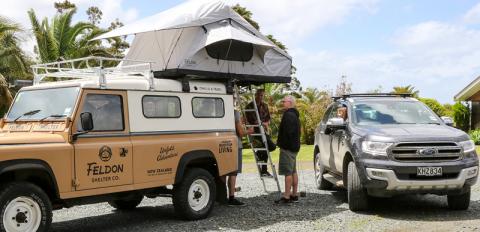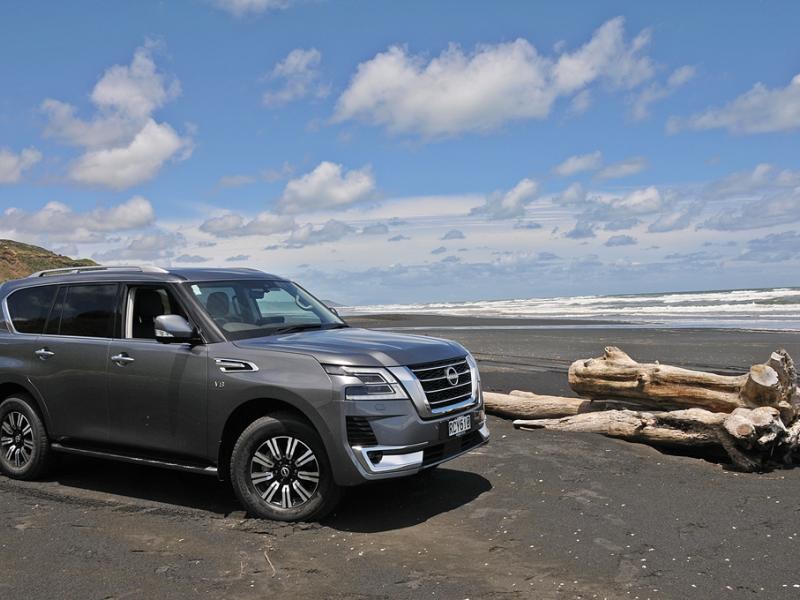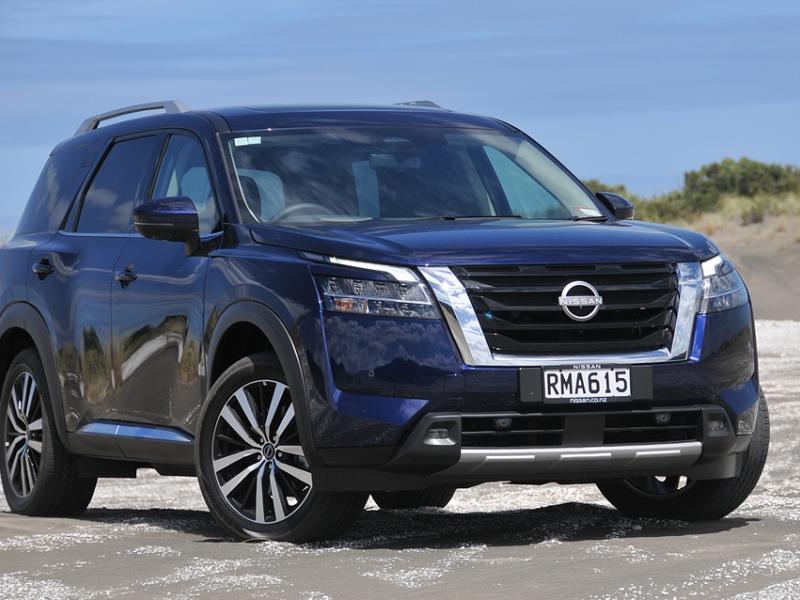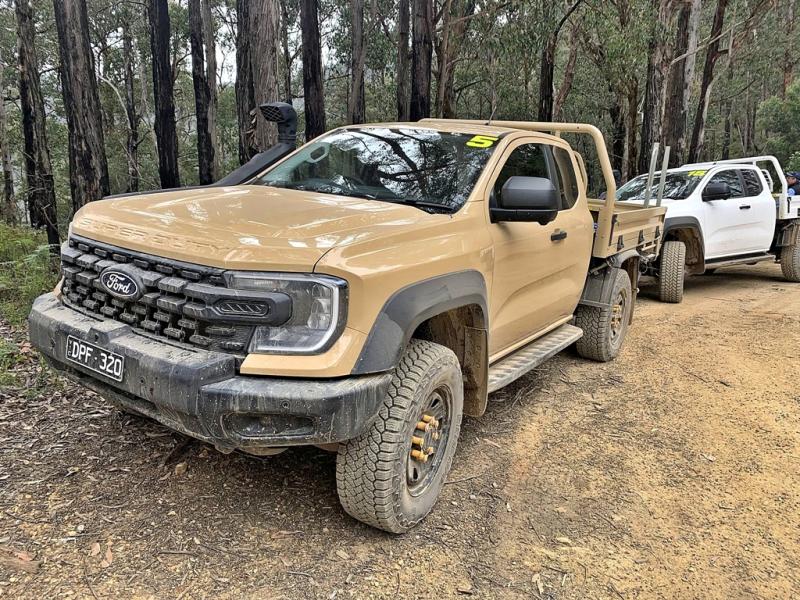Is bigger and tougher always better? We set about finding out by mixing and matching three very different 4WDs, a Ford Everest station wagon, Mazda BT-50 ute and Honda’s latest CR-V SUV.
Story by Ross MacKay, photos by Graham Hughes
OK, the pitch here was simple. Entertainment. Every other car mag (the ones that still exist, anyway) and the big internet sites do these big, sector-specific, comparison tests based on an assumption that – say, you are in the market for a ute – that you want to know the minutiae about every single one on the market.
I don’t know about you, but whenever I have been serious enough about buying something, I have already narrowed down my search and don’t give a toss about the other (worthy I’m sure but not my cup of tea) models in the sector.
Like most of you I suspect, too, I’ve never had the luxury of true, unfettered choice….there have always been compromises…be they budgetary, familial or just a plain old lack of time or needing to replace a vehicle at the ‘wrong’ time.
If, for instance, you were to look at my own personal needs and wants any one of the current crop of turbo-diesel double cab utes – like our Mazda BT-50 here - would do me fine.
However, there are times, wearing my Dad hat (and yes I do have one) that the open tray perfect for dirt and mountain bikes as well as wheels & tyres and bits and pieces of drift car is actually a bit of a negative. Particularly at holiday or even plain simple old family day trip time when each seat is taken and you have a pile of luggage and sports gear you don’t want sitting out in the breeze and/or rain.
Sure you can fit a canopy but that then limits your ability to chuck on a dirt bike…
Better, you think, to buy an equally rugged (ladder chassis, 4WD etc etc) ‘station wagon’ like Ford’s Ranger-based, seven-seat Everest with a luxury interior, better ride, and integral, lockable luggage space, then simply add a tow bar for the MTBs, and small trailer for the dirt bikes.
Not a bad idea, but then you’re talking serious money for an Everest (RRP for the Titanium we tested is $87,990 and even on special it still $76,990) and at GSX-spec level a BT-50 is $55,795.
Which is where the idea of throwing Honda’s new CR-V into the ring came in. Former mag Editor John Oxley positively raved about how good – read capable, practical etc etc – the new ‘un is in his test report in sister mag NZSUV so in the name of coming up with an interesting read we approached Honda, and they came up with an AWD Sport version with an RRP of $47,900.
On paper, there isn’t quite the dollar saving we were looking for, but the Sport is the top-of-the-line version. Honda also does an AWD one in ‘Touring’ spec for $40,700…less than half of the Everest’s list RRP, but it still comes standard with 18 inch alloys. Smartphone connectivity, Navigation, Reversing and LaneWatch cameras, auto headlights and an electric tailgate!
Funny thing too is the Honda’s new hi-tech petrol turbo engine is, at just 1.5 litres, also less than half the capacity of the in-line five-cylinder 3.2 litre turbo-diesel which powers both the Everest and BT-50.
Yet the CR-V is a true and very comfortable 5-five-seater which – as we found out – lacks for little in the, er, keeping-up-with-traffic, stakes. The only real question mark as far as this comparison is concerned is its ability on gravel, sand and grass.
Pick and choose
It’s fashionable at the moment to bitch and moan about Auckland and its traffic issues but if you pick and choose your moment it still provides plenty of opportunities to get away from it all, yet still be less than 20 minutes from a good Flat White.
Try the same in Sydney or Melbourne and after an hour stuck in traffic you’ll still be in suburbia. And in Bangkok or Hong Kong you’ll probably only be in the next block over!
Because it says NZ4WD on the cover, we were never going to limit our test to sealed or even gravel roads but at the same time I wasn’t interested in having to tow any one of the test vehicles out of a bog on old mate’s farm.
What I wanted to find out - in a nutshell – was could a sleek, sporty small/medium SUV hack it with ‘the big boys’ on the sort of day trip many of us idly dream about?
You know….up early, load up the bikes, boards, family/mates and head of the beach or bush, knowing that at some stage we would encounter rough, raw back country roads, the odd farm track and perhaps creek crossing and – if the opportunity presented itself – the odd strop along a beach.
Auckland’s west coast has long been my preferred destination for this sort of comparison test. And by sheer coincidence, the Everest Ford loaned us had just come back from long-term loan to local roof top tent start-up Feldon Shelter.
Social media has been buzzing about the company and its products for over a year now, and with the factory set up on a property near Kumeu I ‘jumped on Facebook’ (as you do) and ‘PMed me up’ (as is increasingly the way these days) a late afternoon meeting with creators Joel Hedges and Beth Eastell.
With such a diverse mix of capabilities I don’t think it is fair declaring a winner, as such, but you might well be surprised with some of the conclusions we (myself and roped in regular testers (Mark Baker and Steve Cardno) come to.
How’d they go? By Mark Baker
Ford Everest
Everest comes to this comparison loaded with extras, features and options. As it reworks its model range to farewell the Falcon, this SUV is the company’s answer to those looking to upgrade from the Territory.
Family focus: quieter than the Ranger it is based on, the Everest is a decent seven-seater as long as the kids get that final set of seats. Trim specification is top-end though not as ostentatious as the Ranger Wildtrack.
Quiet, well-mannered on the road, and very capable on the West Coast sand, the Everest is a true lifestyler. As such it is going to suit families even better than a Wildtrak, with the added security of the SUV body style diverting these buyers away from the double cab diesel ute the range began with.
It does let the driver know that it is heavier than its Ranger sibling though. Getting away from stop signs or on motorway onramps it’s prone to the slightest hesitation and the centre of gravity is different from the Ranger/BT 50, meaning the driver learns to brake slightly earlier to get the big truck settled into a corner.
The 3.2-litre TDCi engine is as strong as always, and copes admirably with the additional 400 kg. But as the range adopts a family look that is shared with the F150, it also suggests that maybe it is time for a strong, sophisticated turbodiesel V6.
Tech highlight: Active Collision Avoidance, the radar-based warning of closing speed between you and the car in front when it seems to the Everest’s on-board computers that a collision is imminent.
Washing mud out from its many crevices the next day, the thought did occur that perhaps a back-to-back with the outgoing Territory might have been a revelation
Honda CR-V
This car rewrote the rule book on its debut last century and the latest version continues to surprise and delight with the level of technology and so many clever little features that it’s hard to know how it hits such a competitive price-point.
A stand-out among the many innovations – flick on the left indicator and a mirror camera shows you the left side of the vehicle – eliminating the blind spot and in off-road conditions showing the driver any hazards they might otherwise guide the vehicle into.
For the first time in the model’s history, the engine is turbocharged, though it’s actually quite difficult to discern the added push. The thing just goes, helped of course by being significantly lighter than the big 4WDs it ran with in this test.
Easily the most road-friendly of the group, the CR-V most evokes that tired cliche ‘car-like’. And yet it’s true. The CR-V ripped along the gnarly little tarmac roads out west and hardly blinked when the surface changed to Woodhill’s volcanic gravel. Out on the beach the CR-V held its own against the more traditional four wheel drives, though I’d only go beach-running in the company of others.
Though it runs a CVT transmission, the flappy paddle shift option gives seven well-spaced shift options and for once the click-shift option is well worth using. It creates clear and firm shift points, communicating each gear’s engagement clearly to the driver.
Active noise cancellation – like those clever earphones people covet for long flights – is becoming a major tool for car makers. Bothe Everest and CR-V have it, and the fact it wasn’t obvious is probably the best measure of how well it works.
With so much clever design on board, this is without dispute the king of value among these three and very much a car for the younger set – a couple or a couple with young kids.
Mazda BT-50
Mazda’s frontline working double cab is immensely capable on and off road. Its engine note and the muted whistle of the turbo remind the driver of its ability and of its shared underpinnings with the Ranger.
In this context, sitting between the Honda and the big Ford, the BT-50 is still tremendously practical for a multi-role vehicle, provided the tick box for a tray canopy is selected. That gives secure storage for tools, toys or groceries and at the same time cuts rear end road noise to a muted hum.
BT-50 is 500 kg heavier than the Honda, but manages its mass well.
Familiarity breeds respect on and off road – the underpinnings of the BT-50 are well sorted and communicate well to the driver. This truck is lighter than the Everest, and shows that in its willingness on tight and twisty roads.
On the beach, it’s a safe understeerer unless provoked on the throttle, when it gradually transitions into oversteer.
Ergonomically, it doesn’t do what the Honda does, nor is it as clever about its dash display and switchgear as the Ford.
But as a midpoint in terms of price, it would be easy to spec a big tough double cab that goes further and does more than the ‘softer’ Honda yet comes in comfortably under the Everest.
How’d they go? By Steve Cardno
This was an interesting test that covered three totally different vehicles, that had different applications but had a similar focus, fun family transport and multi-function usability
Ford Everest
This was the big hitter of the bunch and had that ‘go-anywhere, do-anything’ feel.
It was a solid vehicle and you could feel the weight but with Ford’s five cylinder motor and a nice auto setup it still had plenty of lively, tractable power
The ride was comfy if a little pitchy on the road but very good on gravel roads with holes and corrugations
The Everest is very well appointed equipment-wise with comfy leather seats which have great support for long legs
If you want to do some serious off roading in comfort with a solid vehicle this would be perfect. It would also make a great tow vehicle with the solid chassis and great torquey engine
Mazda BT-50
The Mazda is a good solid vehicle that does everything well, is roomy (up front at least) and with deck and canopy would be perfect for the family and to carry gear in the back.
Despite sharing the five-cylinder engine with the Everest the Mazda’s torque curve felt flatter, though it still drove nicely on the road, definitely more ‘car-like’ than utes of the past.
Off-road the BT-50 proved another very capable vehicle, with the solid chassis and powerful engine giving it a go-anywhere feel - perfect for the family trip with the boat and all of the gear in and on top. great value for the money
Inside the cabin is quite basic compared to the other two, but sometimes keeping it simple is good
Especially if it going to get worked hard during the week the loaded up to do fun things in the weekend.
Honda CR-V
This was more of a soft SUV than the others, obviously, but certainly would well fit the needs of a family heading to the ski fields or perfect beach down that long, winding gravel road (Tauranga Bay anyone?)
What initially surprised me was the amount of room in both the cabin and the ‘boot.’ Seriously, once inside it feels like Dr Who’s Tardus!
The big surprise once underway, though, was the power from the 1.5 litre turbo engine. You would think this wouldn’t make much useful power, but that would be a big mistake. It proved to be a very capable little unit with plenty of power available for any situation
Overall I found the CR-V nice and comfy to drive with a great responsive automatic transmission. It handled very well and tarmac (obviously) and it was also very good on the gravel roads we took it on, so I’d define the Honda as a bit of a ‘do-it-all’ vehicle, albeit in a softer sense compared to the others.
I found all the electronic wizardry very interested, particularly the Lane Assist function which corrects the car back into your lane should you wander out of it.
To sum up, the CR-V is very well equipped, very comfortable and great on the road, so if you are looking for a vehicle that is more town oriented but still good for out of town jaunts it would be well worth a look.
So, what did we decide?
The key conclusions that came out of our day-long drive programme were these.
1) The Everest is probably one of the best, most complete and most capable ‘cars’ Ford has ever produced. Sure you’re paying big bucks for it, but if you are good for it, you are buying the best of both words, a tough, ruggedized, 4x4 chassis, fitted with the a sharp-styled body and the latest cabin comfort and electronic driver aids.
2) If the Honda CR-V is not a candidate for e for next year’s NZ4WD Medium SUV of The Year award then I (as the old saying goes) am a Dutchman! On its own it is a smooth, quiet, roomy, comfortably and economical family all-rounder. Yet in the company of two far tougher 4WD ‘trucks’ it more than holds its own in anything but extreme terrain.
2) And the Mazda BT-50? Big, high-riding turbo-diesel double cab ‘truck’ like it are now New Zealand’s single-most popular style of vehicle. You don’t have to drive one far to work out why either. In short they are just like many of the tradies who buy them; plain, simple, big-hearted lugs who work hard during the week so that they can do what they want to in the weekend.
Best of the Bunch: Ford Everest
Best bang for your buck? Honda CR-V
Most useful single vehicle? Mazda BT-50
To read every story in the NZ4WD Annual go to Zinio.com (Dec 08) or purchase your own hard copy at the Adrenalin store.


